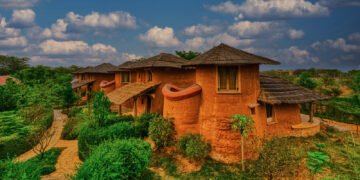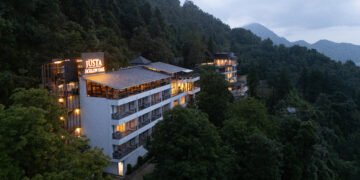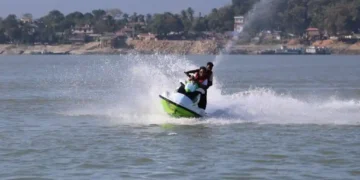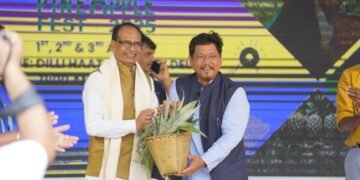No products in the cart.
Meghalaya – Sound of Clouds
Meghalaya is home of clouds
Meghalaya is an all-year destination with different highlights at different periods. Its Capital is Shillong and population is aprox 24 lacs , major speaking languages is Khasi , Garo , bengali , Hindi & English Although Meghalaya can be explore round the year but Oct to March is Ideal for adventure activities like caving and hiking without the fear of excessive rains. This is also the best period to see the crystal clear waters of Umngot River at Dawki and Shnongpdeng, and visit the Wangala Drum Festival.
Apr-May: This relatively warmer period sometimes features pre- monsoon showers, but the weather is pleasant and a good option to beat the heat of the plains.
Jun-Sep: Owing to heavy rainfall at this time, the waterfalls are swollen and come thundering down in their full glory. The misty monsoons are much celebrated in Meghalaya.
The State of Cloude
Meghalaya is clearly divided into three main regions- Garo Hills, central Khasi Hills and the eastern-most Jaintia Hills. Both East and West Khasi Hills and West Jaintia Hills have larger clusters of tourist interest and better infrastructure. Even though entire state is ideal for outdoor adventure, the middle part, along Shillong and Sohra (Cherrapunjee) is well-equipped and gets the maximum footfall. Keep Tura (in the heart of Garo Hills) as the base to discover the northern, eastern and western parts of Garo. For the southern (and least explored) region (Balpakram National Park and around), stay in the closest town, Baghmara.
Culture & Festivals
Seasons, tribal rites and modern signposts are marked with colourful festivals that bring culture and local celebrations to the fore in Meghalaya. In the Khasi region, the Ranikor River Beach Festival (Feb) celebrates the vibrant outdoors of the state. Boating in the Kynshi River, rafting up to the Rilang, snorkelling and scuba diving are part of the celebrations. The three day Monolith Festival (Mar) is held at the Khasi heritage Village, Mawphlang. In Shillong, check out the Weiking Dance Festival (Apr) where women and men celebrate, dressed in traditional costumes. The Autumn Festival (Oct/ Nov) when the city comes alive with fashion, food and music, the four-day Cherry Blossom Festival (Nov); and the Wine Festival (Nov) are colourful events. Garos celebrate the 100 Drums Wangala Dance Harvest Festival (Nov) and the Willian Nagar Winter Festival and Dimchrange Winter
Festival (Dec). The three-day South Garo festival at Ampati celebrates the indigenous culture with local dance. music and theatre. The Bhaghmara Winter Festival, which is a south Garo Tsyam festival, is celebrated on the banks of the River Simsamg. The Discover Jaintia Festival (Nov/Dec) and the Tura Winter Festival and per-Christmas cultural extravaganza held at the Dikki Bandi Stadium in Tura are also fun experiences to catch up on local culture.
PLACES TO SEE:
Nohkalikai waterfall
One of the outstanding natural wonders of Meghalaya is the Nohkalikai waterfall in Cherrapunjee, tumbling over a rock bed, foaming furiously to leap down hurriedly to the bottom. It cascades 1115 feet down to an emerald plunge pool, leaving a misty haze in its wake. The tallest waterfall in India, it attracts swarms of travellers from all over the world.
Nartiang Monoliths
Harking back in history are the hundreds of grey stone monoliths scattered in a large enclosure in the Jaintia Hills. These are generally off the radar for tourists. The Nartiang monoliths were erected some time in AD 1500-1800 during the reign of the Jaintia Kings.
Double Decker Bridge
The most fascinating sights around Cherrapunjee are the incredible root bridges-living rubber fig-tree roots that ingenious Khasi villagers have, over decades, trained across streams to form natural pathways. The roots are braided together to form a solid bridge over rivers. The method is hundreds of years old and it takes almost 40 years to form a complete bridge.
Rainbow Falls
If you could custom build a waterfall-complete with a white frothy curtain, bright blue sky with a rainbow as a backdrop and a mint aqua pool for it to pour into – it would resemble the Rainbow Falls located in Tyrna. The streams that feed it come gurgling from the high mountains, eventually making a single curtain of water and most often a rainbow in the foreground.
Dawki and Shnongpdeng
The photoshop-defying beauty of the Umngot River that passes through Dawki and Shnongpdeng has made curious photographers trek to the southern-most parts of Meghalaya. The glass-like river is best enjoyed from a local dinghy, as you peer down to the bottom of the river bed and spot colourful rocks and fishes. The idyllic circuit of waterfalls, forests and living root bridges is not complete until you visit Dawki and Shnongpdeng.
Laitlum Canyon
The beauty of the crumpled-duvet landscapes and the honey-coloured plateau got Bollywood biggies trundling down to Meghalaya, thanks to the movie, Rock on 2. This previously overlooked gem can expect a fair stomp of trekking boots in the coming years.
SHILLONG
Located in the Khasi hills, Shillong is situated at an altitude of 1496 meters above sea level. The nearest airport is Umroi, 33 km from Shillong. LGBI airport, Guwahati is 128km from Shillong. Helicopter service is also available between Guwahati-Shillong-Guwahati, Shillong-Tura- Shillong and Guwahati-Tura-Guwahati. A network of road connects Shillong with all neighbouring states and major cities of the country.
Shillong is also the headquarter of the North Eastern council (NEC North Eastern Hill University (NEHU), Martin Luther Christian University (MLCU). A bench of the Guwahati High Court ale functions from Shillong The North East Telecom Circle-1 has its headquarters at Shillong. Shillong is also the Regional Head Quarters of Power Grid for North Eastern Region, NEIGRIHMS, the first and the only Postgraduate Medical Institute in the North Eastern Region and third in the country has been established in Shillong Shillong also boasts of having the first Indian Institute of Management (RGIIM), in the North Eastern Region and the 7th in the country. The 12″ National Institute of Fashion Technology (NIFT) has also been set up in Shillong Umiam Lake (Bara Pani)
The man-made reservoir, located 15 km from the heart of the town was built in the 1960s to store water for hydroelectric power generation, but has become a popular sightseeing spot. The roadside lookout point, offering a 180-degree view of the lake, is lined with a row of snack shanties. One can drive down to the Water Sports Complex for boating and other sports. A boathouse, anchored to the Lumpongdeng Island in this mammoth lake, can be rented for overnight stay.
Elephant Falls
The three-tiered Elephant Falls with its tree-scented woodlands are a sight to behold, especially in the monsoon. A well-marked stepped path takes you from tier 1 to 3 down a hill, along slabs of rocks with water flowing over them. It was the British who named the spot Elephant Falls after a rockscape on the left that resembled a pachyderm. Though the rock was destroyed in an earthquake in 1897 the name stuck.
Shillong has many special-interest museums.
Air Force Museum , Wankhar Entomology Museum, Capt Williamson Sangma State Museum. Everling Museum, Don Bosco Centre for Indigenous Cultures , Golf Course , Ward’s Lake, Cathedral of Mary Help of Christians ,All Saints’ Cathedral , Sweet Falls, Shillong Peak (Laitker Peak), Sohliya Village, Mawphlang Sacred Forest ,David Scott trail, Mawxynram, Mawjymbuin cave , Jakrem
Cherrapunjee & Around (Khasi Hills)
Cherrapsunjee is an evocative place. Locally known as Sohra, it has a perpetual cover of cottony clouds when you look up and emerald green hills when you look around.
Nohkalikai Waterfall
Travel on a clear day to the largest plunge waterfall in India (340) meters), as grey clouds often fill the valley, making it invisible from many viewing points.
Mawkdok Dympep Valley
Mawkdok has all the trappings of package tour- Maggi stalls, lookout points, and a highly popular zip lining activity by pioneer Adventure Tours
Wah Kabah
The first waterfall on entering Sohra is the Wah Kabah.
Ram Krishna Mission Museum
The Ram Krishna Mission museum stands beside a temple and school. The museum showcases exhibits from the tribes of the Northeast,
Arwah-Lumshynna Tourist Hub
Enter the Arwah-Lumshynna gate and walk for 150 metres to a paved trail to the caves, rife with stalagmites and stalactites, and vistas of green valleys with rivers snaking past. The complex also has a basic restaurant.
Dainthelen Waterfall
The waterfall stutters over a hunk of black stony bed, corroded with the flow over years. The sheer height and sound of the water falling is awe inspiring.
Nohsngithiang Waterfalls
Seven waterfalls leap off a large U-shaped escarpment, giving them the name Seven Sisters Waterfalls. One can spend hours, watching the clouds drift in and out of the valley and the silver falls.
Mawsmai Cave
This long and complex network of limestone caves has only a section of 150 metres open for travellers. featuring a paved path. The stalagmites and stalactites are a handiwork of nature and well worth the trot, 6km from town.
Kynrem Waterfall
Almost 20km from the Bangladesh border, Kynrem looks like a white sheet hung from a jagged rockscape. Off the road, a viewing pavilion offers a sight of the plunging waterfall.
Motrop (Khoh Ramhah)
This imposing single rock-mound looks like a cross between a large Shivalinga and a hill, and is best seen from a viewing point close to its top. During the monsoons, it is a breath taking sight to see the water flow through two other rocks that lie close by. You can combine this with Kynrem Falls.
Five Bridge & a Waterfall
The starting point of the popular Double Decker Bridge hike is Tyrna village. Some 2500 tiny paved steps descend at least 2000 ft into the valley, rich in oranges, guavas, areca, bay leaf and woodland treasures. At the base is the Long Root Bridge. The Double Decker Bridge is just off the Nongriat villages- a popular spot for hikers and backpackers to spend the night. The bridge hangs over a natural pool of water, formed by the River Umsiang. On the same route, one can also visit the Mawsaw Bridge further ahead. A 3 km hike from the Double Decker Bridge takes you to the Rainbow Waterfall.
Nongwar village
Drive just 3km from Laitkynsew, to see village life at close quarters and a viewpoint called Mawrong. Many people go here before the Tyrna hike for a short warm-up and a view of the forested valley leading to the Double Decker Bridge. You can also spot Mawsynram village right across the hills from here. Umnoi
A new living root bridge is being constructed in Siej village, 2 km off Laitknysew. It may take another 30 years to complete and it is fascinating to see the villagers at work-tugging, shaping and directing roots to weave them together to make a hardy bridge.
Mawlynnong & Around
The sobriquet of the ‘Cleanest Village of India’ has boosted tourism to this faraway village. Rainwater harvesting, a good drainage system, bathrooms in all homes, no plastic and a garbage disposal system are now a way of life for the locals here, Mawlynnong is a day trip from both Shillong (78km) and Sohra (81 km).
Head to the village square, stop for a meal, walk around and leave by the end of the day.
Riwai Living Root Bridge
En route to Mawlynnong from Cherrapunjee, a small village called Riwai offers a 500-metre walk to a living root bridge over a steam. The path is much easier than the one from Tyrna and can be managed by elders too.
GARO HILLS
Rich in rustic character, ancient myths and legends and natural beauty, the Garo Hills offer an undiluted back-to-nature holiday. Dramatic vistas-mostly green and sometimes fractured by a sinuous river- and hamlets of the Garo tribes, make the region a wonderfully secluded find.
To Reach there
Tura, the best base to explore the Garo Hills, lies 219 km from the Guwahati Airport. From the airport, cabs to Tura are available. A helicopter service from Guwahati-Tura (60mins) runs on Mondays, Tuesdays and Wednesdays; but this has limited seating and is dependent on the weather. The nearest railhead is in the north at Mendipathar, but many still prefer Guwahati as the node. NH31 and NH217 connect Guwahati to Tura, via excellent roads, with plenty of highway pit stops in the middle.
Best period to explore Meghalaya is Oct-Mar
Nokrek National Park
The Nokrek Biosphere Reserve includes Nokrek, the highest peak of the Garo Hills, at 1412 meters above sea level. Its steep slopes with deciduous forest cover are hard to climb-one can opt for a 4-wheel drive to go up. This is best visited with local assistance. Located 2km from here is the Tura peak (872m) that awards panoramic views of the undulating green valleys below.
Balapakram National Park
A deep gorge, located in South Garo Hills has a number of trekking routes, and traditional hamlets inside. Balapakram town and some tented accommodation are your only options for an overnight stay. Heavily guarded border posts punctuate the road, skirting the Bangladesh border.
Baghmara Reserve Forest
Located 4 kom from Balpakram, the reserve forest is a hotspot for elephants, along with many other species of birds, animals, reptiles and the famous pitcher plant.
Secure prior permission from DFOs of wildlife West. East Garo Hills, and South Garo Hills to visit Baghmara and Nokrek (megtourism.gov.in/tourismofficers.html)
Chibragare
This picturesque confluence of the Ganol and Rongram rivers, 9 km from Tura, has become a popular weekend picnic spot. Watch out for traffic snarls on Sundays.
Pelga Dare
A cheerful picnic spot, Pelga Dare lies 7km from Tura town on the Ganol River. Cross a bamboo and wire bridge over the gushing river to reach the spot.
Siju Caves
The Siju Caves have dramatic stalagmites and stalactites. One of the longest cave systems in the sub continent, it is home to some of the finest river passages. The limestone rocks are a hook for Siberian ducks who migrate close to the caves.
Chandigre
Nestled between tea and coffee plantations Chandigre Rural Resort features four well-kept cottages on manicured gardens. A day followed by a night’s halt gives you ample time to visit the village and unwind.
JAINTIA HILLS
Jaintia Hills may not be one Meghalaya’s main tourist circuits, but Dawki and Shnongpdeng come to the rescue with their pastoral landscape bordering Bangladesh as well as the near-transparent Umngot River.
How to Reach
Get to Shillong and then drive 66 km to Jowai. Guwahati is the closest railhead, 103 km from Shillong. When to Go: Nov-Feb
Places to see:
Blue Hills Waterfall
Catch the white sheet of water plunging down from a wide stone escarpment from the edge of the Mawlynnong-Dawki road. There is a viewing pavilion right next to the bridge.
Dawki
The border town of the Khasi-Jaintia Hills and Bangladesh is famous for the stunning Umngot River that is as clear as glass in the winter months. At Dawki, go upstream along the sandy riverside banks, stopping at the shanties for a cup of tea. Downstream takes you to the Bangladesh side, which is a crowded and busy picnic spot.
Shnongpdeng
Shnongpdeng is 8 km from the main road. The flat waters of the river reflecting the low mountains and trees make for a surreal mirror impression. The Bright Sun shop in the parking area marks the point from where one needs to walk below to the river beach, where boating and camping kiosks are located.
Krang Suri Waterfalls
Located 31km from Jowai, the Krang Suri waterfalls are in a wide valley close to Amlarem town. One can reach the parking via a rocky, uneven plateau.
Kiang Nangbah Monument
The monument lies adjacent to the river Myntdu. The regal structure commemorates the martyrdom of U Kiang Nangbah who fought against colonial rule.
Tyrshi Falls
Drive off the main Jowai-Shillong road on a bumpy dirt path that opens out onto the flat of a hill with a pine forest. From here, walk along a pathway across a field to reach Tyrshi Falls.
Nartiang Monoliths
The most impressive collection of monoliths in one single area is found in Nartiang (26 km from Jowai). The menhirs known as Moo Shynrang and dolmens (flat stones placed horizontally) called Moo Kynthai date back to AD 1500-1835. The tallest menhir commemorates the victory of U Mar Phalyngki (a lieutenant of the Jaintia King) in a battle.
Nartiang Durga Temple
The temple is adjacent to the ruins of the Summer Palace of the erstwhile Jaintia king. The temple is a Shakti peetha, a shrine dedicated to the cult of the Goddess Sati and, is one of the 51 Shakti peethas for Hindus. Legend has it that the goddess’ left thigh fell on this spot.
ACCESS
Air: Two airports is close to enter Arunachal is Shillong Airport & Guwahati Airport.
Lokpriya Gopinath Bordoloi International Airport (114 km) and Umroi (30km). Direct Air India Flights from Kolkata to Umroi operate every day. Since there is limited connectivity to Umroi, most travellers rely on the Guwahati airport for connections from all major India cities with a wider choice of air carriers.
A helicopter service for Guwahati-Shillong (20 min)-Tura (60 min) operates on Mondays, Tuesdays and Wednesdays. Limited seating and weather dependency make it an unpopular choice, 3642223129, Meghalaya Tourism Centre, Police Bazar, Shillong
Rail: Guwahati is the closest railhead to Shillong (103 km) and a large part of the Northeast. Some of the new trains ply from the second railway station of the city. Kamakhya (106 km).
Cabs to Shillong are available from the airport and railway station. The prices are higher for Cherrapunjee and Tura, the two other major travel destinations. Uber cabs are also available to Shillong and cost a couple of hundred or so less depending on the destination.
Road: Guwahati to Shillong is by NH40. The other major highway, NH44 swings towards Tripura and Mizoram. SHS, NH106 and NH 206 connect to the tourist zones from Shillong. The MTC (Meghalaya Transport Corporation) and ASTC (Assam State Transport Corporation) booking counters are at Police Bazaar in Shillong. Regular buses ply to Guwahati and major towns of Meghalaya from here.
Where to stay/ what to eat
MAWPHLANG
Maple Pine Farm B&B: 9856041205: www.culturalpursuits.com. Lyngkein, Hima Mawphlang, Mawmyrsiang. Base yourself at this B&B, run by James and his wife Valerie.
Susle’s Restaurant: 8575536592: Mawkriah Village, Located in Mawkriah village on the way to Mawphlang, the restaurant offers German Cuisine. The Sunday German buffet is extremely popular. Ri Kynjai: 9862420300: www.rikynjai.com. Umiam Lake, UCCR Rd. A go-to for luxury, Ri Kynjai lies 22 km off the city centre, facing the still waters and forests around Bara Pani.
Hotel Centre Point: 364 2220480; www.shillongcentrepoint.com; Khyndailad, Police Bazaar.
Hotel Polo Towers: 3642222341;www.hotelpolotowers.com; Polo Grounds. Hotel Polo Towers has several selling points.
Pinewood Hotel: 3642223115: www.megtoursim.gov.in; European Ward, Rita Road, overlooking 8 acres of lawns.
Café Shillong: 364 2505759; LP Building, Laitumkhrah Main Rd, Nongkynrih.
Cafe Dylan: 7085056522; Tripura Castle Rd. Dhankheti, Malki.
La Gallerie: 364 222048; www.shillongcentrepoint.com; Khyndailad, Police Bazaar.
ML05: 9612476202; AH 1, near Eastern Air Command.
Little Chef Café: 9089083692; Laitumkhrah Main Rd,
Nongkynrih, Laitumkhrah.
Delhi Misthan Bhandar: 9436103136; Police Bazaar.
Phunga: Laitumkhrah Market.
Munchies: 8974087724; Rani Villa, near Don Bosco Square, Laitumkhrah.
Nightlife Cloud 9: 364 2220480; www.shillongcentrepoint.com; Khyndailad, Police Bazaar.
Polo Irish Bar: 364 2222341; www.hotelpolotowers.com; Polo Grounds.
Orange Roots: 8257060234; Mot Karahi.
7 Sisters Falls View Inn Restaurant: 9862542945: Nohsngithiang.
Harari Restaurant: Opp. petrol pump.
Bansiewdor Dhaba & Rikhasi Dhaba: Nohkalikai.
Nalgre Restaurant: 7578044872; Cherrapunjee Main Rd.
Hala-i-trep: Mawlynnong.
Laikyrr: Mawlynnong.





















